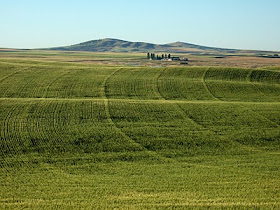Highway 2 traverses across the very northern edge of the Columbia Basin between Wenatchee and Spokane. The road crosses through alternating deep loess soils with winter wheat and channeled scabland where soil was stripped by the Missolula Floods. In this far northern and higher scabland area, stands of ponderosa grow within the joints and fractures in the bedrock and aspen grows in the low scoured out areas where soils are wet.
Granitic outcrop east of Creston.
Blue arrows denote Missoula Flood flow paths that stripped off loess soils
Most of the bedrock along the route is dark brown Columbia River Group flood basalts that covered vast tracts of eastern Washington. However, a short distance east of Creston is a patch of light colored rock. On the western side of the Telford Scabland telford-scabland-highway-2 in one of the deepest channels is a patch of granitic rock. The age of this isolated granite outcrop is not known but it is very similar to granites to the north that are late Cretaceous to early Tertiary associated with Lincoln Metamorphic Core Complex. Hence, this outlier of granite in an otherwise basalt area is likely a southern extension of the core complex. The basalts are thinner in this area of eastern Washington as this area must have been elevated during the Miocene and is a fairly long ways from the Columbia Basalt Group eruptive centers in northeast Oregon and southeastern Washington.
Outcrops of light colored bedrock on road cuts along Highway 2
Outcrop of granite east of Creston
It is not a spectacular outcrop. But it is different compared the much younger Miocene basalts and Pleistocene ice-age landscape that dominates nearly the entire Columbia Basin.The granite along Highway 2 was exposed by the erosion through the somewhat thin basalts in this area by the Missoula flood waters creating a window to the rocks underlying the basalt. Of coarse a few miles to the north is the deep Columbia Rviver valley incised down through the basalts into the underlying complex series of core complexes and older grabbens filled with sediments and volcanics from the period prior to the great Miocene flood basalts covering the area.
Creston Butte, a short distance to the west and just south of the town of Creston, is underlain by much older gneiss of very uncertain age. It has been correlated with similar units that are Ordovician in age as well as similar units that are Precambrian in age. Its isolated position surrounded by miles of basalt and Pleistocene sediments combined with very complex geology underlying the basalts poses a difficult geology interpretation challenge.
Creston Butte
Road to the summit and radio towers on Creston Butte.
The summit area of Creston Butte was likely never covered by the basalt lava flows. This butte is one of several buttes that consist of much older rock rising above the surrounding Miocene Columbia River Group flood basalts. Isolated buttes that protrude through lava flows are referred to as steptoes. The termed is derived from Steptoe Butte located on the eastern side of the Columbia River Group flood basalts. The higher elevation above the surrounding landscape exposes the summit of Creston Butte as well as the other buttes in the area to higher winds and more erosion through storm water run off and prevented them from being completely covered entirely by eolian silts like much of the surrounding land.
I try to imagine Miocene mammals living in eastern Washington gathered on Creston Butte and other steptoes driven to these high points by lava flows. Would have been a great place to watch the flood basalts cover the land. And Creston Butte was the high point on another island during the Missoula floods.
Creston Butte is not exactly a spectacular summit, but it is the furthest west steptoe rising above the flood basalts. A couple of more steptoes are located just south of Davenport along highway 2 and these buttes are mapped as being underlain by Precambrian gneiss.
Buttes south of Davenport






No comments:
Post a Comment